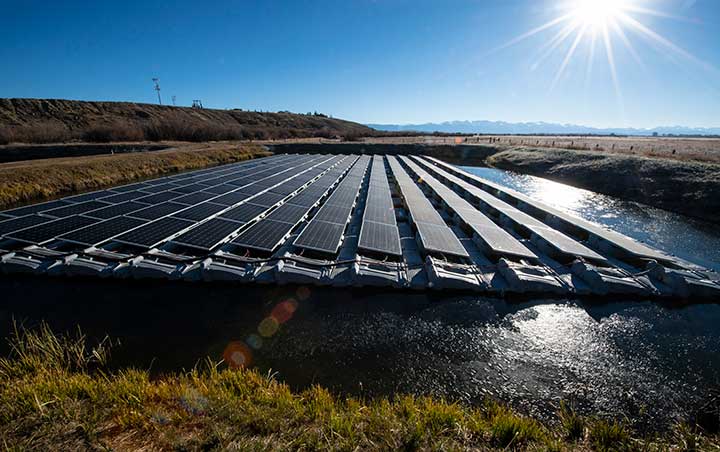The Advanced Energy Partnership for Asia
USAID and NREL are leading the Advanced Energy Partnership for Asia, a collaboration between USAID and the U.S. Department of Energy's national laboratories that supports the Asia Enhancing Development and Growth through Energy (EDGE) initiative.

Asia EDGE
Asia EDGE is a U.S. whole-of-government initiative to grow sustainable and secure energy markets throughout the Indo-Pacific region.
USAID plays a leading role within Asia EDGE to help partner countries expand energy access, promote energy diversification and trade, and strengthen energy security across the region.
Supporting Sustainable and Secure Energy Markets across Asia
The Advanced Energy Partnership for Asia is a collaboration between USAID and the U.S. Department of Energy's national laboratories to enable advanced energy systems for secure, resilient, and sustainable economic growth across Asia.
Key Opportunities
The Advanced Energy Partnership for Asia concentrates on key opportunities within partner countries, such as:
- Utility performance: Improving energy utility planning and operational practices to increase advanced energy system implementation
- A level playing field: Assisting governments in fostering supportive policy, legal and regulatory environments for private sector deployment and investment in advanced energy systems
- Data-driven decision-making: Increasing the use and availability of high-quality data to drive energy sector analysis and decision-making
- Regional integration: Advancing regional energy system planning and operation practices for efficient cross-border energy trade.
Advanced Energy Systems
The Advanced Energy Partnership for Asia will work with partner countries to conduct research, analysis, and capacity-building to deploy advanced energy systems including:
- Renewable energy at scale
- Energy efficiency
- Electric vehicles
- Battery energy storage systems
- Microgrids
- Resilience and energy security planning
- Distributed energy generation, and
- Digitalization.
Impactful Work
The Advanced Energy Partnership for Asia is making an impact in the region with the following work.
Proactive Transmission Planning in the Philippines
The Competitive Renewable Energy Zones Transmission Planning Process—a USAID collaboration with the Philippines Department of Energy—helps to plan, approve, and build transmission infrastructure to connect geographic areas with high-quality renewable energy resources and private sector interest to the power system. This process supports the reliable and economic integration of renewable energy—helping the country to reach ambitious clean energy targets. Read the NREL news story.
ASEAN Interconnection Master Plan Study III
The Association of Southeast Asian Nations Centre for Energy is leading a regional effort to update the ASEAN Interconnection Master Plan Study III (AIMS III) to guide discussions of multilateral power trade in the region. The Advanced Energy Partnership for Asia will draw on NREL’s extensive power system modeling and planning experience to provide expert advisory support to AIMS III.
Floating Solar Photovoltaics in Southeast Asia

Floating solar photovoltaics (PV) is an emerging application in which solar PV systems are sited directly on water bodies. This regional project aims to identify best practices that enable the deployment of floating solar systems in Southeast Asia and characterize how this emerging technology could potentially complement existing hydropower generation in the region.
Learn more about Floating PV in Southeast Asia:
Enabling Floating Solar Photovoltaics Deployment: Technical Potential Assessment for Southeast Asia, NREL Technical Report, (2023)
Enabling Floating Solar Photovoltaics Deployment: Policy and Operational Considerations, NREL Presentation, (2022)
Enabling Floating Solar Photovoltaic Deployment: Exploring the Operational Benefits of Floating Solar-Hydropower Hybrids, NREL Technical Report, (2022)
Enabling Floating Solar Photovoltaic Deployment: Review of Barriers to Floating Solar Photovoltaic Deployment in Southeast Asia, NREL Technical Report, (2021)
Southeast Asia Renewable Energy Data Explorer – Powered by the Advanced Energy Partnership for Asia
The Southeast Asia Renewable Energy Data Explorer will support the collection, development, and open dissemination of critical data sets, such as high temporal and spatial resolution solar resource data and allow for visualization and analysis to inform key decisions. High-quality data that has high temporal and spatial resolution will allow countries to compare clean energy options with conventional choices—leveling the playing field for renewable energy and ensuring that decision-makers can identify the least-cost option that achieves their goals. To learn more, visit the RE Explorer website.
Asia EDGE Power Sector Learning Series
No-cost, virtual trainings share cutting-edge approaches to enable competitive markets for clean energy technologies across Southeast Asia. View the webinar series.
Advanced Energy Partnership for Asia Fact Sheet
DownloadShare